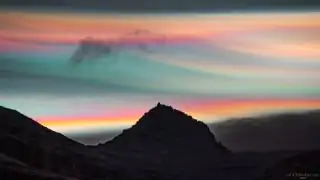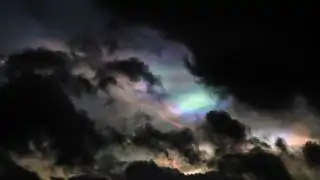The dark skies in the Arctic Circle recently shone with ethereal multi-colored light. But this jaw-dropping spectacle was not caused by auroras. Instead, the iridescent rainbows were caused by clouds of tiny ice crystals floating higher in the atmosphere than is normally possible.
The clouds, known as polar stratospheric clouds (PSC), only form when the lower stratosphere reaches temperatures below minus 114 degrees Fahrenheit (minus 81 degrees Celsius). Normally, clouds do not form in the stratosphere because it is too dry, but at these extremely low temperatures "widely-spaced water molecules begin to coalesce into tiny ice crystals" that form into clouds, Spaceweather.com reported. This means PSCs can form much higher up than normal clouds, between 9.3 and 15.5 miles (15 to 25 kilometers) above the ground.
As sunlight shines through these crystal clouds, it gets scattered, creating multiple different wavelengths of light, which has inspired the PSCs nickname, "rainbow clouds." Due to the extreme altitude of the clouds sunlight can hit the crystals and scatter above an observer even if the sun is beyond the horizon, which is when these clouds appear brightest.
On Jan. 25, extreme freezing conditions in the stratosphere allowed for a rare outbreak of PSCs across the Arctic Circle, including Iceland, Norway and Finland, according to Spaceweather.com. Amateur photographer Jonina Gu?run Oskarsdottir captured a stunning shot of the vibrant clouds above the peak of Mount Jokultindur in Iceland and photographer Fredrik Broms took a series of snaps of the colorful lights above Kvaloya near Tromso in Norway.
Related: Solar storm smashes hole in Earth's magnetosphere, triggering extremely rare pink auroras
There are two types of PSCs: Type I, which are made from a mix of ice crystals and nitric acid, which produces less spectacular colors and may be linked to the formation of ozone holes; and Type II, which are composed of pure ice crystals and produce more vivid colors. The ones that recently formed over the Arctic were Type II.
Type II PSCs are often referred to as nacreous clouds because their iridescent hues can sometimes resemble nacre, also known as mother of pearl, which is produced in the shells of some mollusks. However, they are much rarer than Type I clouds.
—Bizarre 'Levanter' cloud billows off Rock of Gibraltar in breathtaking time-lapse video
—Striking satellite photo captures Mount Vesuvius peering through a hole in the clouds
—Bizarre cloud of gas is one of the longest structures in the Milky Way
Type II clouds typically occur no more than two or three times a year in the Arctic, normally during the colder winter months, according to Spacewaether.com. However, experts believe that both types of PSCs could occur more often in the future as climate change creates more extreme weather, which could have a knock-on impact on the ozone layer if more Type I clouds can form, according to NASA.
Due to their intense colors, nacreous clouds are often confused with the northern lights, or aurora borealis, in the Arctic. These more common phenomena occur when highly energetic particles emitted by the sun travel down the magnetic field lines of Earth's magnetosphere.





